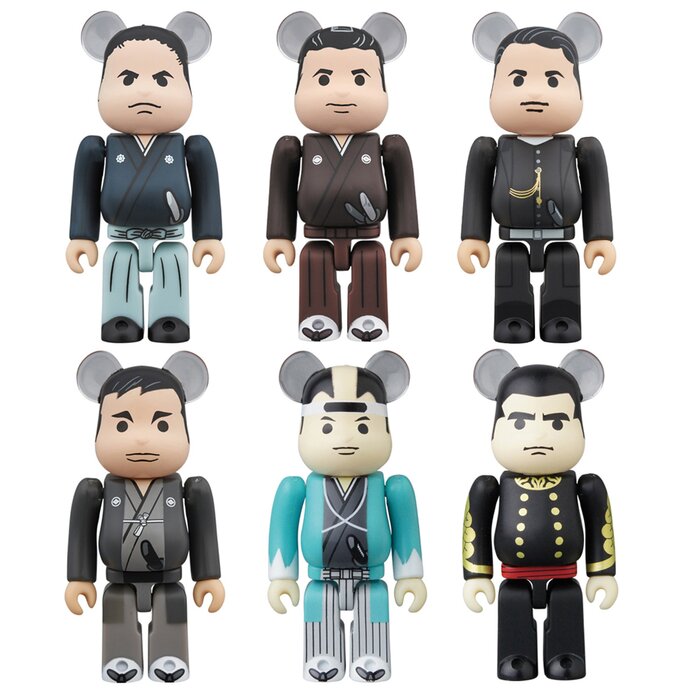 Bakumatsu Era - BE@RBRICK
Bakumatsu Era - BE@RBRICK
Medicom Toy's BE@BRICK line famously includes high-profile collaborations with designers and artists around the world. However, the toy line also includes figures from Japanese history in the brand's distinct, collectible form. The "BE@RBRICK Bakumatsu Collection" represents six figures from one of Japan's most popular time periods.
Bakumatsu Era and BE@RBRICK Collaboration Background
In addition to media and artist collaborations, Medicom Toys makes BE@RBRICK figures based on mythical and historical figures.
Collaboration Planning and Launch
The Bakumatsu Era collection rolled out in the three-part launch at the end of 2017. The first set, featuring Souji Okita and Takamori Saigo launched in October. In November, the Shinsaku Takasugi and Toshizo Hijikata pair was released. Lastly, the Kaishu Katsu and Ryouma Sakamoto went on sale at the end of December.
BE@RBRICK Bakumatsu Collection
Japanese history fans can own a full set of influential figures in this collection from Medicom Toy's BE@RBRICK line. The set contains six important warriors and politicians from the tumultuous Bakumatsu period. Each figure features an approximately costumed appearance representing their most significant role in history.
The Souji Okita figure depicts him wearing the iconic blue haori donned by the Shinsengumi. Toshizo Hijikata wears his western-style military outfit from his famous late-life photo portraits. The Kaishu Katsu figure has him dressed in clothing suited for his role as a Bakufu aligned naval officer. Takamori Saigo wears the military outfit featured in an oil painting of him completed after the Meiji Restoration. The Ryouma Sakamoto figure shows him in a loose, casual kimono, highlighting his hair as his distinguishing feature. Similarly, the Shinsaku Takasugi figure depicts him with the short, side-swept hairstyle from his most famous portraits.
- Product Name: BE@RBRICK Bakumatsu Collection
- Manufacturer: Medicom Toy
- Specifications: Painted & articulated plastic figure
- Height (Approx.): 70mm | 2.8"

Bakumatsu Era Background
The Bakumatsu Era is a popular period of study during Japanese history. Due to the tumultuous nature of the era, studies range from examining military politics to covering social upheaval. The time period frequently appears as a setting in pop culture, particularly in the drama and romance genres.
Bakumatsu Era Background: History
Bakumatsu refers to the final years of the Edo or Tokugawa period in Japanese history before the Meiji Restoration of 1868. Previously, Japan existed under a decentralized military government with similarities to European feudalism. After over 200 years of nearly total isolation, Japan faced foreign intrusion from US forces in 1853. The intrusion called the current political system into question and created an ideological split among the ruling class.
Pro-Imperial nationalists wished to open Japan to foreign influence to gain global power while reinstating the Emperor as head of the government. Pro-Shogunate forces wanted to maintain the standing political system. The period culminated in the year-long Boshin War with victory going to the imperialist nationalists. The shogun's elite forces, the Shinsengumi, have been romanticized in pop culture for their futile sacrifice and ultimate defeat.
Bakumatsu Era Important Figures
Many political and military figures rose to prominence during the Bakumatsu Era. However, the members of the Shinsengumi remain the most well-remembered characters of the time with one notable exception.
Toshizo Hijikata
Toshizo Hijikata was a commanding warrior in the Shinsengumi during the Bakumatsu period. In 1862, he joined the Roshigumi, a group of masterless samurai that would eventually form the Shinsengumi. Hijikata became vice-commander of the Shinsengumi after ousting and assassinating the previous two leaders. During the Boshin War, Hijikata and Commander Kondo Isami led the Shinsengumi in their final battle before relocating to Edo. After a year of fighting the new government, Hijikata led a raid in the Battle of Miyako Bay. He later died during the final battle of the war, the Battle of Hakodate. His role as leader of the Shinsengumi makes him a widely popular and romanticized character in pop culture.
Souji Okita
Souji Okita is one of the most famous members of the Shinsengumi known for his highly skilled swordsmanship. Okita was considered a kenjutsu prodigy, mastering the preferred style of the Shinsengumi by age 18. He was one of the youngest members of the Shinsengumi and served as an assistant to the vice-commander. Okita famously suffered from tuberculosis, a disease that would eventually kill him in 1868. However, there is public and scholarly debate on when he contracted the disease. Like Toshizo Hijikata, Okita is a popular, romanticized figure in modern pop culture. Due to his young age at death, in his mid-20s, Okita is often portrayed as a handsome "bishounen" character.
Ryouma Sakamoto
Ryouma Sakamoto was an influential figure and politician during the Bakumatsu Era. After the long-avoided introduction of foreign influence in Japan, Sakamoto opposed the Shogunate's position on a closed Japan. He advocated for imperialism, Japanese nationalism, and moderate modernization and technological advancements. His most notable contribution to the era's politics was his successful negotiation of the Satcho Alliance against the standing Bakufu government. Sakamoto was assassinated in 1867, one year before the Boshin War and Meiji Restoration. Sakamoto has been depicted in countless tv dramas, manga, and video games. There are currently two museums dedicated to his life in Japan and an asteroid named in his honor.
Links
BE@RBRICK Bakumatsu Collection
BE@RBRICK Series
BE@BRICK Label